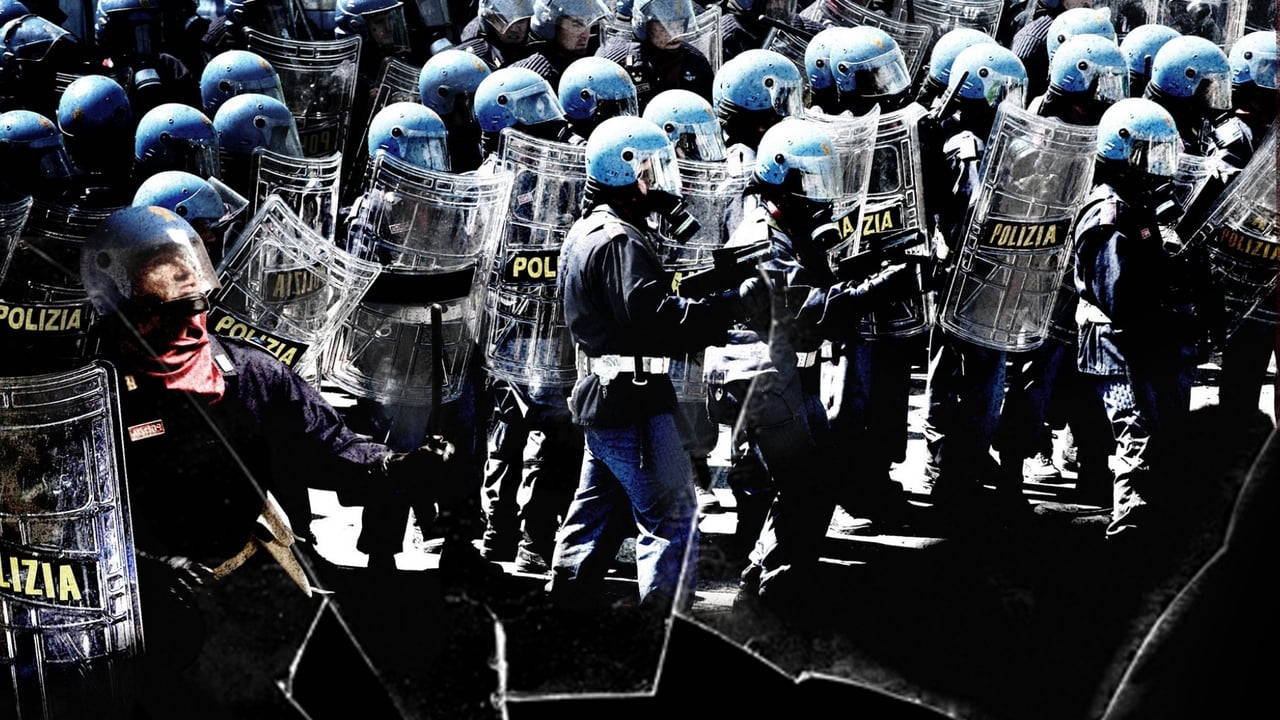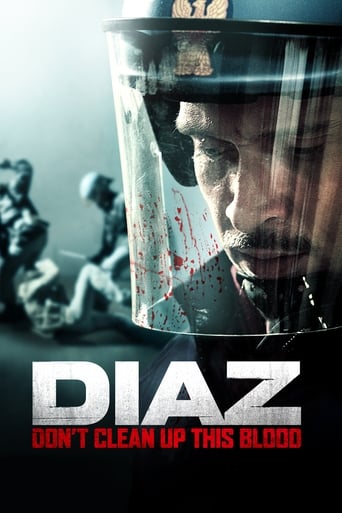Inclubabu
Plot so thin, it passes unnoticed.
Huievest
Instead, you get a movie that's enjoyable enough, but leaves you feeling like it could have been much, much more.
Micah Lloyd
Excellent characters with emotional depth. My wife, daughter and granddaughter all enjoyed it...and me, too! Very good movie! You won't be disappointed.
Keeley Coleman
The thing I enjoyed most about the film is the fact that it doesn't shy away from being a super-sized-cliche;
Elain-ee
I just can't believe that even now, there are people like one reviewer on this page who are so nakedly towing the fascist party line on Genoa. The Diaz raid WAS as bad as this film makes out... at least, according to the severely injured and traumatized protesters, it was. And, call me crazy, but their take on the events matters a lot more to me than what some disconnected overseas film critic who wasn't even there has to say. Especially a critic who is more or less quoting the same anti-communist lines that the police in this film dispensed as they were beating people up...! That aside, I want to say that this film, while overlong and brutal, is extremely hard to stop watching because it is so heartfelt. I was 24 when these events happened and I was attending the equivalent actions in London. Being that we were all so connected to the global anti-globalization movement (if that's not a contradiction in terms?) my friends and I were among the first people outside of Genoa to hear about the events at Diaz. Back then, I assumed from the descriptions given by Indymedia that it was pretty awful (they described the blood on the floor and walls, as well as the fact that women and elderly people were beaten in their sleep). Even so, I still didn't grasp the full extent of the damage until I saw this re-enactment. What would have been a good addition to this film, though, would have been to show some of the aftermath, in which various countries pursued justice for their respective citizens and were rebuffed by the Italian authorities with what can only be described as fascist zeal. This left the rest of Europe shaken, I believe, in the same way that the abuse meted out by the police left the left activist scene shaken. It was also a telling moment in the anti-capitalist movement, because it demonstrated how little the values of the masses actually mattered to the elite.One interesting commentary that kind of sums the whole event up was made by Nick Davies of the Guardian, eight years after the fact. He wrote that, at Genoa, "the police acted as though somebody had promised them impunity". Since none of the assailants ever served time for their crimes, we can safely assume that that promise was upheld... and continues to do so. But by whom? I guess the answer lies is in the name of the entity whose summit the Genoa Social Forum was protesting against.
Marcus Nessuno
In Late April 2009, I got a call in London to come to Genova to meet several mystery guests who wanted to meet me and several of the other Diaz victims. I was coming anyway to see Dr Zucca (The Genova prosecutor) but I was intrigued to find out who the mystery guests were. I met Domenico Procacci and Daniele Vicari in Genova at the Via San Luca office (where the Diaz case is archived) in late May for a 'secret weekend meeting' after the Cannes Film Festival.At the time, I did not know who Procacci and Vicari were but I was told they were the best film producer and director in Italy and they wanted to make a movie of the raid on Diaz during the G8. I had seen Gomorrah, Procacci's mafia film and thought it was brilliant. Using this film as a comparison, I listened to what Domenico wanted to say to all of us present. Procacci explained to us that he had wanted to make a multi-million euro film about the raid for a long time but had been prevented because the trial process against the police.He was willing to risk a lot of money on the project and we could all see that Domenico and Daniele were committed to making the movie. I personally told them that whilst I had a lot of personal confidence, I thought the Diaz police would try and stop the project or the right ring politicians like Berlusconi or Fini my sue Fandango. I also told them that Diaz is still live court case and that they had to do a lot of research.After all of us from Diaz consulted with each other, we gave Domenico Procacci and Daniele Vicari permission to make the film. All of us were taking a risk allowing a production company like fandango access to the video evidence & photos and documents involved in the trial. However, we all felt that the story of the raid and what we had lived through had to be told to the rest of the world.What is unusual about the Diaz movie was that there was no script in existence, so Fandango commissioned Laura Paolucci to spend two years writing a script. The end result is a pulp fiction style film which is 80% true to the story of Diaz. Obviously, Vicari could not go into detail about the entire G8 which forms the backdrop for the beginning of the film but I think Vicari has done an almost perfect job of marrying together true events with a few high drama fictional characters.I think the combination of powerful high impact footage, recreated scenes and the chance of lifting the lift on the inside of the anti-globalization movement makes Diaz the movie a special film. The 2001 G8 was the biggest and worst riot in Europe in 60 years. To complete the film, Vicari has combined the usual high quality style of Italian film screening to capture this important moment of history, making it one of the best, most talked about and most controversial films to come out of Italy in 20 years.Only after the film had premiered in Berlin did I learn that Procacci had said that Diaz had been his most challenging and complicated film to make…with Vicari in agreement.My story is played by an Italian actor Pietro Ragusa and my almost death is one of the penultimate scenes in the movie. Because I ran out of Diaz, I took the full force of Canterini's unit, the 7th Mobile heavy riot unit that had specially trained for the Genova G8 summit. Pietro's part is almost as it exactly happened and I am very happy despite the scene is one of the most harrowing.
tomas-klesken
What happened on that day and is portrayed in the movie is nothing new.All of us have seen what happened in Abu Ghraib, concentration camps, even on socker matches or concerns... we all know that people behave like swine when they are given the opportunity and even worse, when they are in "authority" (in any sense).I have tried to read a book by psychologist Philip Zimbardo, that explains the topic of violence brought in common people if they are given an order or authority to do so... couldn't, it didn't feel realistic enough to follow. I saw the Experiment, based on his work and didn't find it realistic again - it felt like fiction.Than this movie came. I seriously would make it an obligatory part of police and soldier training. To show them what they can become if they don't watch themselves... I would show it on psychology lessons to make the students understand that the beast in us is very much alive. Its a movie that partly kills the "humans are nice" mindset, but sometimes it needs to be done - the risks of forgetting are too high.When I left the cinema I was thinking if there is anything that can be done from MY side to prevent such things from happening... All i came to was to be good - to spread the feeling of connection with strangers, to try and make any matter personal. This movie made me consider joining the police just to see and try to not allow anything like this to happen. Thank you for this, I don't know what will be my role, but movies like this make me realize, that living for my own self is just not enough (one day I might be sorry for doing so.. if I find myself on the wrong end of the baton).
hkarlovac
People need to understand that this is a *drama* not a documentary. Drama as in the dramatization. It was a terrible event in actuality, but this goes way overboard in depicting brutalization just for the shockfactor, of which there is plenty. It goes completely overboard. Actually, the filmmakers should be ashamed of themselves for exploiting what happened just to make a buck. It is very unfortunate that some ignorant people will assume that just because it is in a movie it is true. It is not. This film is a classic communist style "agitprop" film: agitation propaganda, made for the purpose of provoking the audience to action. Action in ignorance is as bad as no action. While people have a right to be outraged on the basis of an actual documentary or reading actual news accounts, this piece of fiction is not it.

